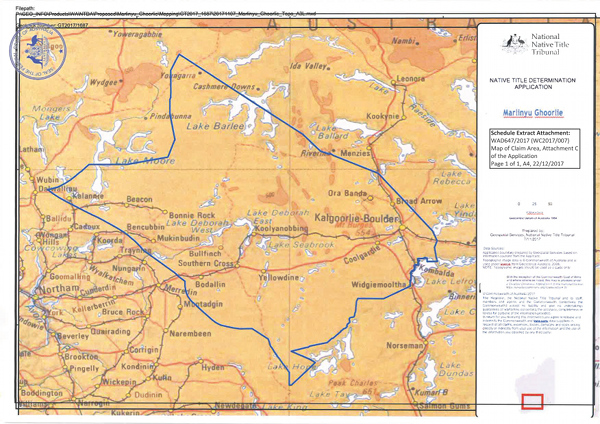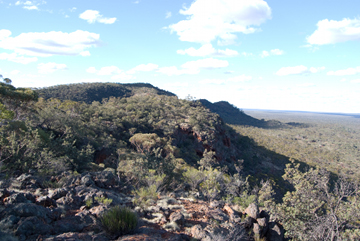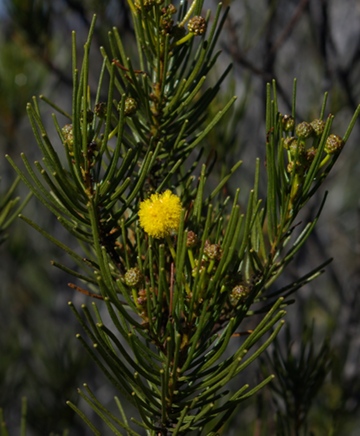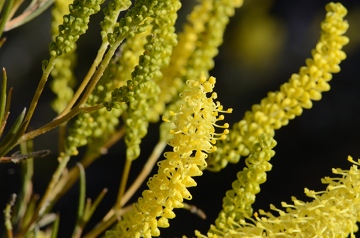Traditional Owners of Range
Traditional Owners of Bungalbin
Helena and Aurora Range
Indigenous Custodians of the Range
Indigenous Cultural Heritage of Helena and Aurora Range (Bungalbin)
The Indigenous custodians (Traditional Owners, TOs) of Helena and Aurora Range are of the Kapurn Nation. The language spoken is Kaalamaya or Kalamaia (sometimes spelt Kalamai). The Traditional Owners refer to their language group as Kaalamaya Kaprun or sometimes Kalamaia Gubrun (Elder Brian Champion Senior, pers. comm.). The people of the Kapurn Nation call the Helena and Aurora Range, Bungalbin (a Kalamaia name).
The Kapurn Nation extends from just south of Paynes Find down to where the Holland Track begins (south of Hyden), east to Riverena and Goongarrie and west to Burracoppin and Mukinbudin.
A Native Title claim for their country was submitted in December 2017, accepted for registration in March 2018, and is currently undergoing the process of Determination. The claim area includes Bungalbin (Helena and Aurora Range).
Publications that include some of the history of the people of the Kalamaia Kapurn Nation are:
Westonia, The Wheels of Change by Jocelyn Maddock, and
Explorers Routes Revisited - Clarkson Expedition 1864 by Lesley Brooker.
People of the Kalamaia Kapurn Nation
The Kalamaia Kapurn people believe that the Helena and Aurora Ranges (Bungalbin) needs to be given back to them. That their ‘ownership’ or custodianship of this land be recognised by both Federal Government and State Government, as well as government departments (eg. Department of Biodiversity, Conservatrion and Attractions, Forest Products Commission, Department of Primary Industries and Regional Development).
The Kapurn people want to be given their rights as Wardens, Custodians and Traditional Owners of the ranges (Bungalbin). They want to be given “first say in management” so that “we can keep our culture in our sights, looked after and intact.”
The Kapurn people do not want mining on Bungalbin (Helena and Aurora Range).
The whole of Helena and Aurora Range (Bungalbin) is considered to be sacred and in need of protection.
Elder Brian Champion speaks out for Bungalbin in two short videos - produced in 2016. Videos: Brian Champion
Aboriginal Sites on Helena and Aurora Range (Bungalbin)
On Helena and Aurora Range (Bungalbin), there are a total of 16 Aboriginal sites that have been lodged on the Register: seven were Registered in December 2016 and the remaining 11 sites are referred to as Other Heritage Places (source for registered sites: Department of Aboriginal Affairs (DAA) website and Aboriginal Heritage Inquiry System viewed 9 February 2017; source for other sites: Department of Aboriginal Affairs (DIA) website, December 2011; viewed 15 January 2012). Other Heritage Places have yet to be fully assessed by the Aboriginal Cultural Material Committee (ACMC). Five of the 11 'Other' sites have been given the status of ‘insufficient information’. The 16 sites are listed under Aboriginal Sites on Bungalbin.
Not all Aboriginal sites are recorded on the Register and some sites may no longer exist. However, “the Aboriginal Heritage Act 1972 protects all Aboriginal sites in Western Australia whether or not they are registered.”(DIA website, 15 January 2012).
The information of sacred sites is continually being updated. For an update on the sacred sites on Helena and Aurora Range go to the Aboriginal Heritage Enquiry System (AHIS) on the DPLH (Department of Planning Lands and Heritage*) website.
Native Title
Aboriginal people ‘come from country’ where it is the country of their ancestors (where their ancestors were born to).
Within the country of the Kapurn Naton there are two native title representative bodies. The Goldfields Land and Sea Council and the South West Aboriginal Land and Sea Council. Helena and Aurora Range falls just within the boundary of the South West Aboriginal Land and Seas Council (in the north-east corner).
In December 2017, a Native Title Determination Claim was applied for, titled the Marlinyu Ghoorlie Claim. It was accepted and registered in March 2018. Currently undergoing the process of Determination, which includes determining the fibal boundary of the Native Title claim. The map of the claim area, when submitted for registration in December 2017, is provided below. It represents the country of the Kalamaia Kapurn Nation.

Attatchment C of Native Title Determination Application - Marlinyu Ghoorlie
(source: National Native Title website - visited May 2018)
Indigenous Land Use Agreements (ILUAs)
Legal voluntary agreements between native title groups and others can be negotiated and developed in regard to the use of land and waters. They are referred to as Indigenous Land Use Agreements (ILUAs). ILUAs are developed between two parties, the Traditional Owners and other land-use 'owners' (e.g. the State government or mining companies) and are submitted to be accepted for registration by the National Native Title Tribunal (NNTT).
Where the ILUA covers the area of a proposed national park - the agreement is negotiated between the Department of Biodiversity, Conservation and Attractions (DBCA) and the native title group (Traditional Owners) and usually includes agreement to create the national park in their country, joint management of the proposed national park and a Rangers program. It is the policy of the DBCA that national parks and ILUAs DO NOT extinguish Native Title.
Where the ILUA covers an area proposed for development, such as mining, it can cover topics such as; native title holders agreeing to a future development, access to an area, compensation, employment and economic opportunities for native title groups, extinguishment of native title, how native title rights coexist with the rights of other people, and cultural heritage. (adapted from NNTT website: see page)
* Department of Planning, Lands and Heritage includes the - Western Australian Planning Commission, Aboriginal Lands Trust, Government of Western Australia Development Assessment Panels, and Heritage Council.
References
Maddock J (1998) Westonia The Wheels of Change, A History of the District. Shire of Westonia.
Brooker L (2012) Explorers Routes Revisited - Clarkson Expedition 1864. Hesperian Press, Carlisle, Western Australia.



